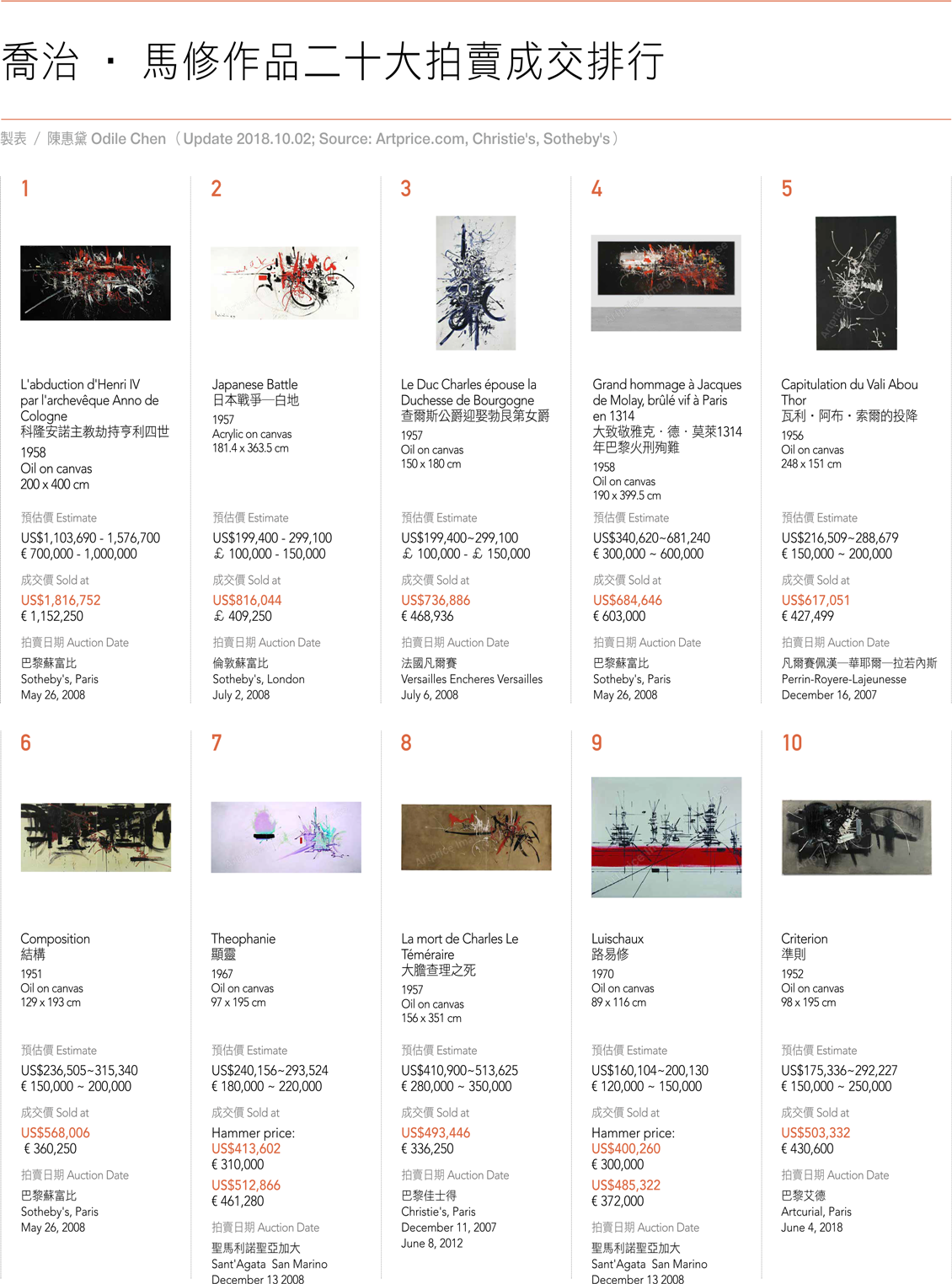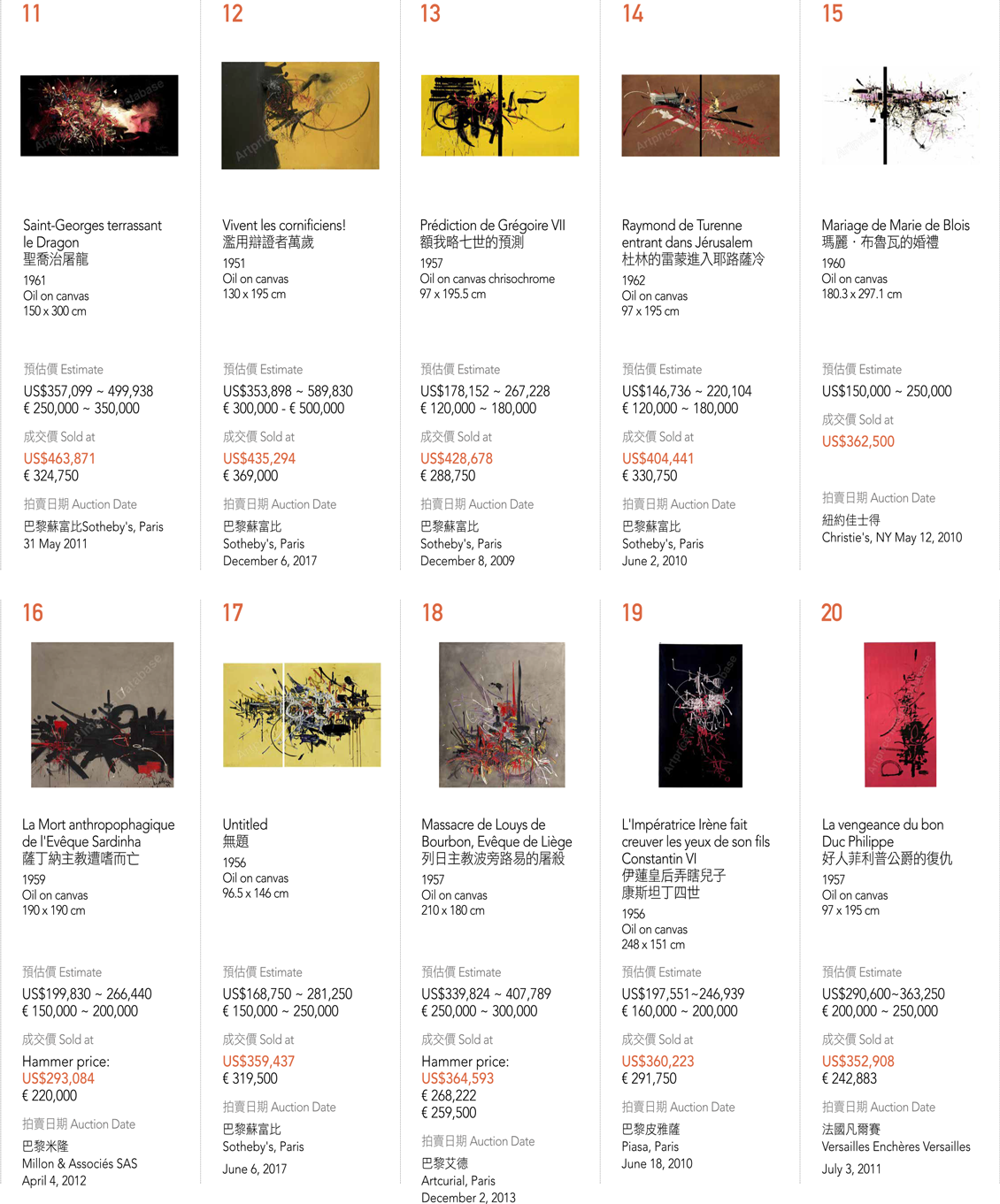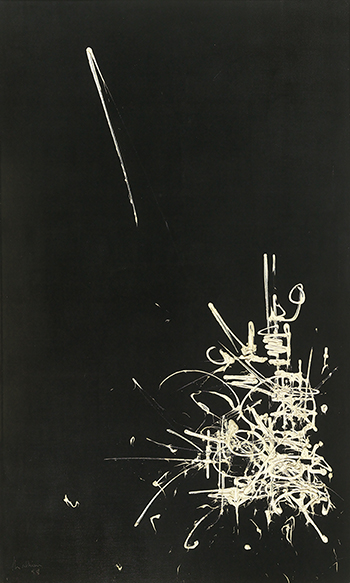Art Column
Composing Grand Epics with Rapid - Georges Mathieu, The Father of Lyrical Abstraction
Odile Chen / Ravenel Quarterly No. 27 Winter 2018 / 2018-10-31

In an evening auction in Hong Kong on September 30, 2018, a huge-scale oil painting 10 meters wide was sold for HK$ 510 million (approximately NT$2 billion or US$ 6.5 million), becoming the most expensive oil painting ever auctioned in Asia. The creator of that painting was the Chinese abstract art master Zao Wou-ki (1920–2013). Zao was one of the lyrical abstractionists popular in post-WWII Europe. Lyrical abstraction emerged in the late 1940s in Paris. Its founder was Georges Mathieu (1921–2012), a friend of Zao. Mathieu and Zao shared many similarities: they lived and died in nearly the same period; both lived into their 90s; both were Aquariuses, who are full of imagination; both were royal descendants; both were sons of rich bankers; both were lyrical abstractionists, and their works reflect the spirit of oriental calligraphy; and both became members of the Académie des Beaux-Arts for life, Mathieu in 1976 and Zao in 2002.
AN ART MASTER WHOSE PAINTINGS ARE SEVERELY UNDERPRICED
Georges Mathieu was self-appointed as the father of lyrical abstraction. He was charming both in leadership and performances on the stage. His threedimensional embossed painting lay the foundation for lyrical abstraction, which played a critical role during the reconstruction process in post-war France and was able to counter the influence of cold abstraction, or geometric abstraction. Indeed, Mathieu’s status in art history is superior to that of Zao and has been affirmed by art critics and art historians. He was a superstar in the 1950s and 60s. In the 70s, he became a national-level master. During his lifetime, he held numerous exhibitions around the world and over 170 solo painting performances. His works have been collected by over 90 major museums. However, the prices of his paintings do not reflect his glorious experience and influence.
For many years, the market price of Mathieu’s works has been severely underrated. Although he was once the pioneer of French avant-garde art, to date, the highest price of one of his works at auction was US$1.82 million, only approximately one-third of that of Kazuo Shiraga, a Japanese master of abstract art. The prices his works have achieved are no comparison to the US$300 million of the American abstract artist Willem de Kooning, the US$86.88 million of Jack Pollock, the US$65 million of Zao, or the US$6.885 million of Pierre Soulages. Despite a report in Le Figaro on September 24, 2018, exclaiming, “Georges Mathieu entame sa renaissance” (The Georges Mathieu Renaissance Has Begun), the price for purchasing Mathieu’s works privately has exceeded Euro 2 million (approximately NT$72 million or US$ 0.232 million), still not matching the true value of his works. Still, various signs have indicated that the value of Mathieu’s works is about to soar.
The main reason why Mathieu’s works are underpriced is that the market transactions have been overly concentrated in France and not enough in other parts of the world. According to the database Artprice, over 60% of Mathieu’s works were sold in France, about 16% in Great Britain, less than 10% in the United States, and the rest in other countries. Unlike the New York and London markets or the emerging markets in Asia, which are proactive and competitive, the Paris market is relatively conservative and cautious. Additionally, the long-lasting national prejudice that foreign arts are superior to domestic arts has resulted in the French market constantly praising foreign artists and neglecting French contemporary artists. Even artists with high prestige, such as Mathieu, the father of lyrical abstraction, and Bernard Buffet, the master of figurative paintings, do not receive the respect they deserve.
Luckily, driven by global capital flow, the prices of works by Mathieu and Buffet in the art markets outside France have been gradually rising, making up the gap in the French market. The prices have been continued to rise especially in auctions in emerging markets in Asia, including those in Japan, South Korea, China, Hong Kong, and Taiwan, where French contemporary artists are favored.
Post-war abstract arts have been attracting substantial market attention in recent years. Works by several representative artists of the New York School have been sold at astronomical prices. Likewise, the Gutai arts in Japan, the Dansaekhwa (Korean Monochrome Painting) and the Punto movement in Italy are major themes promoted by auction firms. The European lyrical abstract art represented by Mathieu has been presented by Zao from China, whose works have been sold at historically high prices one after another in the past year. The lyrical abstraction in Paris and the abstract expressionism in New York were the focus of the two sides of the Atlantic Ocean and the most critical art movements after WWII.
A POST-WAR ART NOBILITY
Georges Mathieu was a critical French abstract painter, a theorist, and a member of the Académie des Beaux-Arts. Mathieu was born to a banking family on January 27, 1912, in Boulogne-sur-Mer in northern France. Boulogne-sur-Mer is an ancient harbor city where several cultural heritages are preserved, and it is only a strait away from Great Britain. Mathieu’s full name was Georges-VictorAdolphe Mathieu d'Escaudoeuvres, a combination of glorious saints of the Middle Ages. Mathieu shared the same birthday as the classical music composer Wolfgang Amadeus Mozart and was of a noble birth. His ancestry can be traced back to the royal family. He studied Latin from a young age. When he was 12, his family moved to Versailles. In junior high school, he studied Greek, Russian, and Spanish. In university, he acquired a bachelor’s degree in English. All of these reflect his talent in languages. When he was growing up, his family moved to several places, and he was surrounded by monuments from the Middle Ages. That together with his noble blood made him enthusiastic about historical events. The events during the reign of Louis XIV and the romantic sentiment of absolute monarchy fomented in his heart and developed into his later unique, honorable taste.
When Mathieu was 20, in the midst of WWII, he studied law. He was not interested in law but was fascinated and enchanted by philosophy courses. In 1942, he started painting. He created without academic training. In his early stages, he mainly composed landscape paintings and portraits. He understood that paintings, like music, required interpretation to prove their existence. This characteristic of fervent sentiment and his free, imaginative spirit determined that he would later turn to lyrical abstraction. In 1944, he decided to follow the path of non-figurative paintings, and at such a young age, he started his exploration of the abstract world.
In his early abstract paintings, Mathieu studied amorphous shapes and experimented with the dripping technique.On a background of gray or red tone with layers,he used black oil paint to drip out non-figurative shapes.He also directly squeezed strips of oil paint from tubes to spread them on the canvas, creating embossed profile and texture. This method requires painting at an extremely high speed so as to control the paints and to create smooth and intuitive expression. Mathieu was the first painter to employ the dripping technique,slightly earlier than the presentation of Pollock’s works in 1947. Mathieu felt that this technique was too random and soon moved on to other styles. In 1944, he served as a translator for the US Army, and he once worked as a professor at a US military university in southwestern France. During that period,his painting skills grew further.He became more and more at ease when splashing colors and squeezing paint from tubes to paint. In 1946, his abstract painting debuted in“Salon des moins de 30 ans”(Salon for the under 30s) in Paris, attracting considerable attention.
In 1947, Mathieu moved to Paris,the City of Arts.Because of his proficiency in foreign languages,he became the public relations manager for United States Lines, where he met many rich business people and people with high social status.When in Paris, he proactively interacted with artists.He shared similar ideals with the German painter Wols.He assumed the position of leader and planned the first“L’Imaginaire”(Imagination) non-figurative joint-exhibition at Galerie du Luxembourg in Paris.Other participants included 14 painters from various countries,notably Wols, Jean-Michel Atlan, Hans Hartung, and Jean-Paul Riopelle. The title of this joint-exhibition was “Towards Lyrical Abstraction.”It became even more famous because of the inclusion of works by Pablo Picasso and Hans Arp. The members of the lyrical abstraction movement later included painters such as Michel Tapié, Francis Picabia, and François Stahly.Mathieu supported freedom in the arts and promoted the concept of lyrical abstraction.
Mathieu no doubt was the first painter to introduce American abstractionism to France.He introduced the latest arts of Pollock and Alton Tobey to French viewers. In 1948,under his arrangement, US and French avant-garde painters competed against each other.Zao from China was later included in the 1950s.

THE AESTHETICS OF SPEED; WESTERN COLOR CALLIGRAPHIST
In addition to hosting exhibitions, Mathieu was also involved in researching art informel. In 1949, he participated in the joint exhibition “Huit oeuvres Nouvelles” (Eight New Works) together with Jean Dubuffet, Jean Fautrier, Maria Martins, and Wols. Mathieu enjoyed studying different art styles. In 1950, he first attempted the style of Tachiste and launched a solo-exhibition. He was also inspired by Hans Hartung and developed a style of action painting with lines like calligraphy. In 1950, the French Minister of Culture and art critic André Malraux visited Mathieu’s painting exhibition at Galerie René Drouin in Paris and commented, “Enfant un calligraphe occidental!” (Finally, a Western calligrapher!) Clearly, Mathieu’s works reflect oriental Zen and calligraphy.
In the 1950s, Mathieu travelled to the United States and Japan, and he held painting exhibitions in different countries to expand his horizons and his life. During this time, he started to compose large-scale paintings with a single color as the background and without drafting as his spontaneous emotional expression. He also started composing a series of paintings to pay homage. Although what he composed were abstract paintings, his topics were often related to history, and most of the works had titles. Mathieu was able to compose fast and perform in front of the public. He transformed creation into improvised action art. Because of the fast speed, he had to overcome the control of the mind and the possibility of reproducing from memory; as a result, his creations were adventurous and full of wonder.
The most famous example happened in May 1956. Invited to an international theater festival, Mathieu put on makeup and performed action painting in front of an audience of 2,000 at the Théâtre Sarah Bernhardt in Paris, completing a 4 × 12 m large-scale over painting under the title “Hommage aux poétes du monde entire” (Homage to the Poets of the Whole World). This wild, avant-garde art form was shocking and challenging to the gentle French culture.
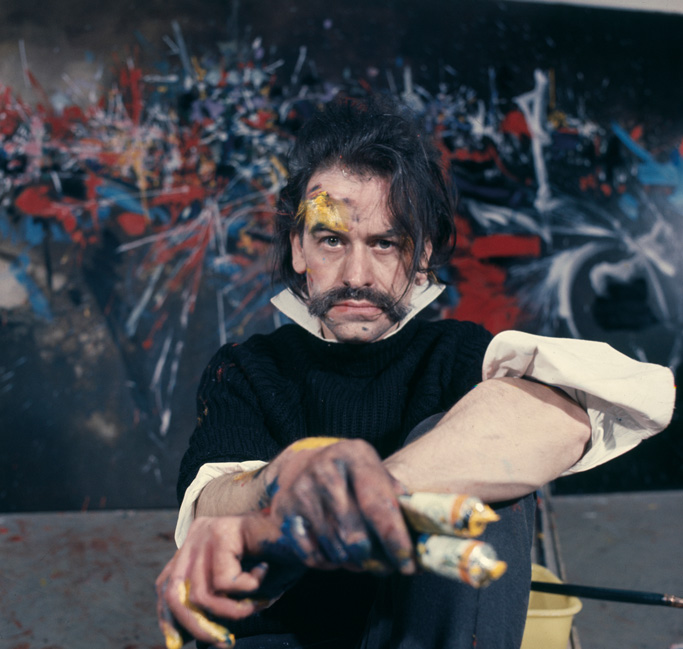 Mathieu always dressed handsomely. He was good at exerting his charm on stage, and he did not shy from painting in front of an audience. He included improvisation and performing elements into his paintings. In front of the crowd and facing a large-scale canvas, he was like a handsome bullfighter in the arena. After meditating and becoming focused, he started a splendid fight. His performance, powerful and beautiful, was a brand-new form of art.
Mathieu always dressed handsomely. He was good at exerting his charm on stage, and he did not shy from painting in front of an audience. He included improvisation and performing elements into his paintings. In front of the crowd and facing a large-scale canvas, he was like a handsome bullfighter in the arena. After meditating and becoming focused, he started a splendid fight. His performance, powerful and beautiful, was a brand-new form of art.Mathieu’s innovative art has had a profound influence. He inspired the “Art Happenings” of Allan Kaprow in 1957, and Yves Klein’s “Anthropometry” series. He was also admired by the founder of Gutai art in Japan, Jiro Yoshihara, who praised Mathieu and Pollock, for their arts had “gotten rid of the traditional norms.”
Mathieu was in close contact with artists of the Gutai Art Association (1954–1972) in Japan. In 1957, he donned a Japanese kimono and composed on the rooftop of a department store in Osaka, stunning the audience. His creative method of directly using tubes of paint to paint on canvas echoed the Gutai ideas of “using tools and the body to present” and “abandoning the use of conventional brushes.” His techniques are still employed by later artists. For example, do not Ayako Rokkaku’s way of painting with fingers and Miwa Komatsu’s way of on-site performance using paints in tubes pay homage to Mathieu?
Before Mathieu’s exhibition in Japan, he completed 21 oil paintings in Tokyo in 3 days, reflecting his astounding physical strength and ample creativity. His skillful integration of painting and performance into a creative art form surpassed Yves Klein or artists in the late 1950s and early 1960s. A critic exclaimed, “For the first time, painting becomes performance!” Possibly because of Mathieu’s special connection with Japan and oriental calligraphy, the late director of the National Museum of Western Art in Japan, Soichi Tominaga (1902–1980), praised Mathieu as “the greatest French painter since Picasso.” The American art critic Clement Greenberg visited his painting exhibition at Kootz Gallery in New York and praised him as “the most important European painter.”
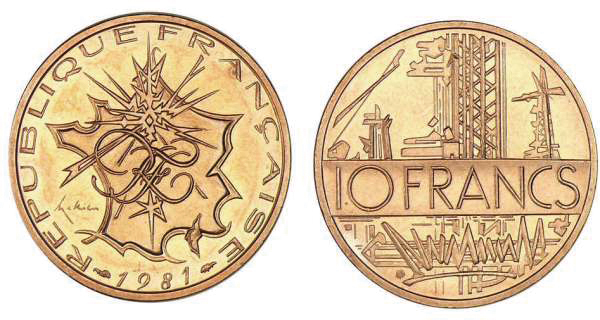
GIFTED AND EXTRAORDINARY PERSONALITY
In the 1960s, Mathieu expanded his creativity into other aspects of life. He became a fashion designer, attempted large-scale sculpture, and composed books on theory, displaying diverse talents. He once designed posters for Air France, logos for two television companies in France, and furniture. Château Mouton Rothschild, one of the five major wineries in Bordeaux, invited him to design wine labels. The wine label for the top-quality 1961 wine was designed by him. His work of the largest scale and widest popularity was commissioned by the Monnaie de Paris. Over 100 million copies of the 10-franc coin he designed were issued. That coin was in circulation for 14 years, from 1974 to 1987.
Starting as a great western calligrapher in the 1950s, Mathieu became a prince of the art scene in the 1960s and a revered art master in the 1970s, and he received the highest honor in 1976—membership in the Académie des Beaux-Arts. His paintings are stunning, like lightning and fire, filled with dazzling symbols and signs. His paintings shine with emotional power, fierce and mystical. Since the 1980s, due to the regime transfer in France, Mathieu was considered right wing, and his outspokenness did not fit into the system of that time. Consequently, he gradually faded away from the political world and the spotlight. His painting style, beginning in this period, revealed a new maturity, exceeding classicism and abandoning his central image. The range of his use of color expanded, entering a different level.
During Mathieu’s lifetime, three critical retrospectives were held. The first one was in the National Museum of Modern Art in Paris in 1963. The second was in Rmn-Grand Palais in 1978. The last retrospective was in The Galerie nationale du Jeu de Paume in 2002. In 2012, he passed away at the age of 91 due to illness. His splendid life ended, and all his glory turned to dust.
The famous painting merchant and historian Daniel Wildenstein (1917–2001) once told Mathieu, “Votre peinture montre une jeunesse et une évolution que seuls des artistes comme Titien et Monet ont accompliés” (Your paintings show a youth and an evolution that only artists like Titian and [Claude] Monet have accomplished.) Since Wildenstein was an expert on Monet, Édouard Manet, Gustave Courbet, and Paul Gauguin, this was extremely high praise!
In recent years, art galleries in Paris have constantly held Mathieu solo exhibitions and introduced his life and works. People in the French art scene maintained that Centre Georges Pompidou owed Mathieu a retrospective. It is clear that the call to restore Mathieu’s reputation and status is increasingly louder. People in the French art scene have also noticed that in auction markets in Asia, including those in Hong Kong, Taipei, and Shanghai, more and more works by Mathieu are appearing. At the 2018 International Contemporary Art Fair, Mathieu again became one of the topics of discussion. Will the prices of Mathieu’s works finally rise?
